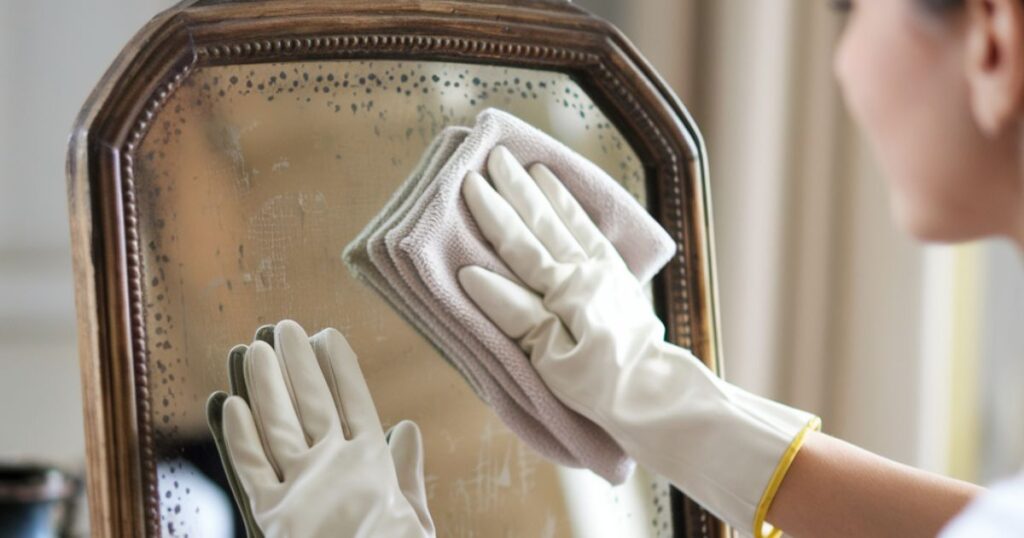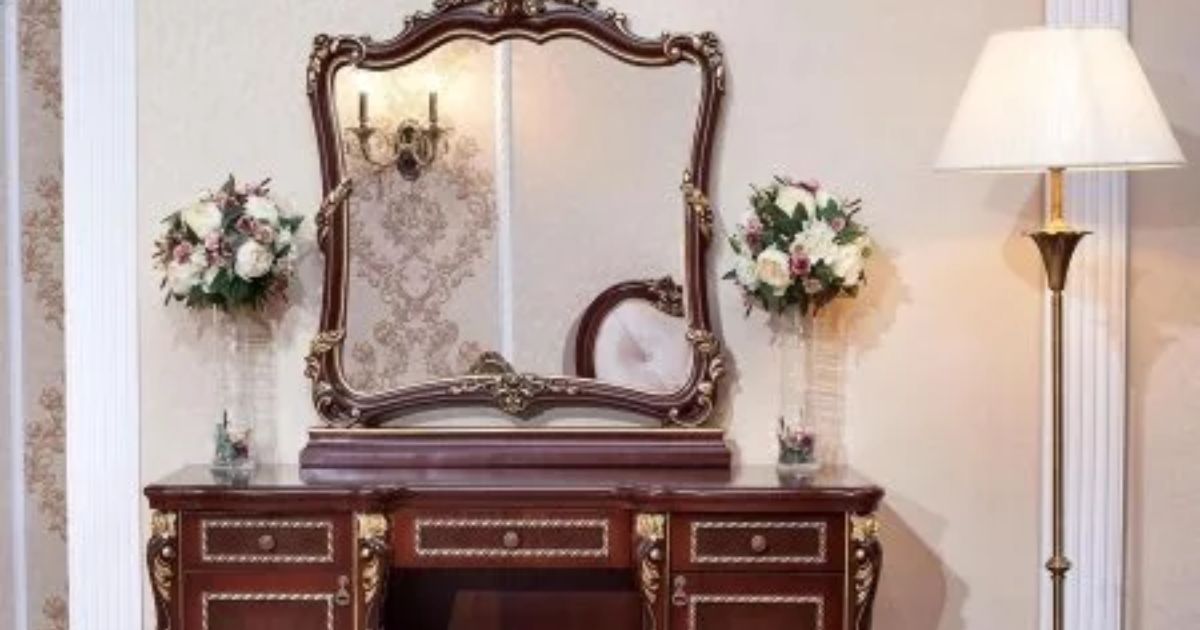Antique mirrors aren’t just reflective surfaces; they’re portals to the past, whispering tales of bygone eras through their silvered glass. But as time marches on, these treasured pieces can lose their luster, obscuring the stories they’re meant to tell. If you’ve found yourself wondering how to clean an antique mirror without damaging its delicate surface or erasing its cherished patina, you’re in the right place. This guide will walk you through the intricate process of restoring your antique mirror to its former glory, preserving its history while ensuring it continues to captivate for years to come. How To Clean An Antique Mirror?
Preparing the Mirror for Cleaning: The First Step in Antique Mirror Care
Before you dive into the cleaning process, it’s crucial to prepare your antique mirror properly. This preparatory phase can make the difference between a successful restoration and irreparable damage.
- Assess the mirror’s condition: Take a close look at your mirror in good lighting. Note any areas of concern, such as:
- Flaking or peeling silvering
- Cracks or chips in the glass
- Loose or damaged frame components
- Identify problem areas: Pay special attention to:
- Cloudy or hazy patches
- Dark spots or “desilvering”
- Accumulated grime in ornate frame details
- Test cleaning solutions: Before applying any cleaner to the entire mirror, pick an inconspicuous spot to test. This could be a corner or a part of the frame that’s not easily visible. Apply a small amount of your chosen cleaning solution and observe any reactions.
Remember, antique mirrors are often more fragile than their modern counterparts. The silver on the back of the glass can be easily damaged, and old glass may be more prone to scratching. Approaching the cleaning process with caution and respect for the mirror’s age is paramount.
What You’ll Need: Assembling Your Antique Mirror Cleaning Kit
Gathering the right tools and materials is essential for safely cleaning your antique mirror. Here’s a comprehensive list of what you’ll need:
| Essential Supplies | Recommended Cleaning Agents | Protective Gear |
|---|---|---|
| Soft microfiber cloths | Distilled water | Rubber gloves |
| Cotton swabs | White vinegar | Dust mask |
| Soft-bristled brush | Rubbing alcohol | Safety goggles |
| Spray bottle | Mild dish soap | Apron |
| Lint-free towels | Commercial glass cleaner (ammonia-free) | – |
Pro tip: Always opt for the gentlest cleaning method first. Harsh chemicals can do more harm than good when it comes to antique mirrors.
How to clean antique mirror glass: A Step-by-Step Guide

Cleaning the glass of an antique mirror requires a delicate touch and patience. Here’s a detailed process to follow:
- Dust removal: Start by gently removing loose dust with a soft, dry microfiber cloth. Use light, circular motions to avoid scratching the surface.
- Prepare your cleaning solution: Mix equal parts distilled water and white vinegar in a spray bottle. For stubborn grime, you can add a drop of mild dish soap.
- Apply the solution: Lightly mist the mirror’s surface. Avoid saturating the edges where moisture could seep behind the glass.
- Wipe clean: Using a fresh microfiber cloth, gently wipe the mirror in a circular motion. Pay extra attention to areas with visible dirt or film.
- Address stubborn spots: For persistent marks, dip a cotton swab in rubbing alcohol and carefully target the area. Be cautious not to let the alcohol touch the frame or seep behind the glass.
- Dry and polish: Use a lint-free towel to dry the mirror thoroughly. Follow up with a final buff using a clean microfiber cloth to restore shine.
“Cleaning an antique mirror is like peeling back layers of time. Each gentle wipe reveals a clearer reflection of history.” – Anonymous Antique Collector
Remember, the goal isn’t to make your antique mirror look brand new. The patina and slight imperfections are part of its charm and historical value. Aim for cleanliness while preserving the mirror’s aged character.
How to Clean the Film Off Mirrors: Tackling Stubborn Residue
Over time, antique mirrors can develop a filmy residue that dulls their reflective quality. This film can be tricky to remove without damaging the delicate surface. Here’s how to approach this challenge:
- Identify the type of film:
- Mineral deposits from hard water
- Soap scum (common in bathroom mirrors)
- Oxidation of the mirror’s backing
- Gentle cleaning methods:
- For mineral deposits: Create a paste with baking soda and water. Apply gently with a soft cloth, then rinse with distilled water.
- For soap scum: Use a solution of one part white vinegar to four parts warm water. Apply with a soft cloth, then buff dry.
- For oxidation: This is trickier and may require professional restoration. Avoid harsh chemicals that could further damage the mirror’s backing.
- When to seek professional help: If the film doesn’t respond to gentle cleaning methods or if you notice any changes in the mirror’s appearance after cleaning, it’s time to consult an expert in antique restoration.
Cleaning Old Antique Mirror Glass: Special Considerations

Very old mirrors present unique challenges and require extra care. Here are some specialized techniques:
- Use distilled water exclusively: Tap water can contain minerals that may leave residue or react with the old glass.
- Consider a commercial antique glass cleaner: Look for products specifically formulated for antique mirrors.
- Be extra gentle: Old glass is often more brittle and prone to scratching. Use the softest cloths available and avoid applying pressure.
How to Restore Shine to Old Crystal: Bringing Back the Sparkle
Crystal mirrors, with their higher lead content, require a slightly different approach:
- Dust thoroughly: Use a soft, clean makeup brush to remove dust from all crevices.
- Clean with mild soap: Mix a few drops of mild dish soap with warm distilled water. Clean using a soft cloth, then rinse with clean distilled water.
- Polish with a microfiber cloth: Buff the dry crystal with a clean microfiber cloth to restore shine.
- Consider professional polishing: For severely dulled crystal, professional polishing may be necessary to restore its original brilliance.
How to Clean Glass With Vinegar: A Natural Solution
Vinegar is a fantastic, natural cleaning agent for antique mirrors. Here’s how to use it effectively:
- Create the solution: Mix equal parts distilled water and white vinegar in a spray bottle.
- Apply sparingly: Lightly mist the mirror or apply the solution to a soft cloth first.
- Wipe gently: Use soft, circular motions to clean the surface.
- Buff dry: Use a lint-free cloth to dry and polish the mirror.
Caution: While vinegar is generally safe, always test on a small area first, especially with very old or valuable mirrors.
How to Clean Film on Glass Tables: Adapting Mirror Techniques
The principles of cleaning antique mirrors can be applied to glass tables:
- Use the same gentle cleaning solutions (vinegar and water or mild soap and water).
- Apply solutions to a cloth rather than directly to the table to prevent seepage into joins or decorative elements.
- Pay extra attention to edges and corners where grime can accumulate.
- For stubborn marks, use a plastic scraper designed for glass surfaces to avoid scratching.
How to Update Out-Of-Date Bathroom Mirrors: Refresh Without Replacing
Sometimes, an old bathroom mirror just needs a little TLC to look its best:
- Deep clean: Use the methods described earlier to thoroughly clean the glass.
- Frame refresh: Consider painting or refinishing the frame for an updated look.
- Add new hardware: If the mirror has visible mounting hardware, replacing it can give a quick, modern update.
- Apply a protective coating: After cleaning, a professional can apply a protective coating to prevent future tarnishing.
Why Does Mirror Glass Get Foggy? Understanding the Science
Mirror fogginess can occur for several reasons:
- Moisture exposure: Bathrooms are particularly prone to this issue.
- Temperature fluctuations: These can cause condensation on the glass surface.
- Chemical reactions: Cleaning products or airborne substances can react with the mirror’s backing.
- Age: The silvering on very old mirrors can naturally degrade over time. How To Clean An Antique Mirror?
To prevent fogginess:
- Control humidity in the room
- Use exhaust fans in bathrooms
- Avoid harsh chemical cleaners
- Keep mirrors away from direct sunlight
How to Fix a Cloudy Mirror: DIY Solutions
For minor cloudiness, try these steps:
- Deep clean: Use the vinegar solution method described earlier.
- Rubbing alcohol treatment: For stubborn cloudiness, try rubbing alcohol on a soft cloth. Be cautious as this can affect the mirror’s backing if overused.
- Buff with newspaper: After cleaning, buff with crumpled newspaper for extra shine.
If these methods don’t work, or if you notice the cloudiness worsening, it’s time to consult a professional restorer.
How to Clean Mirror Frames: Preserving the Whole Package
Cleaning the frame is just as important as cleaning the glass:
- Identify the frame material: Common materials include wood, metal, and plaster.
- Dust thoroughly: Use a soft brush to remove dust from all crevices.
- Clean gently:
- For wood: Use a slightly damp cloth with mild soap, then dry immediately.
- For metal: A solution of warm water and mild dish soap works well. Dry and polish with a soft cloth.
- For gilded frames: Extreme care is needed. Often, just dusting is safest.
- Preserve ornate details: Use cotton swabs to clean intricate areas.
FAQs: Your Antique Mirror Questions Answered
How do you clean a cloudy antique mirror?
Start with a gentle vinegar and water solution. If that doesn’t work, try rubbing alcohol applied sparingly with a soft cloth. For persistent cloudiness, consult a professional restorer.
What is the best cleaner for old mirrors?
A mixture of equal parts distilled water and white vinegar is often the safest and most effective cleaner for old mirrors. Avoid commercial cleaners with harsh chemicals.
How do you restore an antique mirror?
Full restoration often requires professional expertise. However, gentle cleaning, careful repair of the frame, and addressing minor silvering issues can often be done at home with patience and the right techniques.
How to remove haze from an old mirror?
Try the vinegar solution first. If that doesn’t work, a paste of baking soda and water applied gently can help remove haze. Always test in an inconspicuous area first.
Conclusion: Reflecting on Antique Mirror Care
Cleaning an antique mirror is more than just a household chore; it’s an act of preservation. By following these guidelines, you’re not only maintaining a beautiful piece of decor but also safeguarding a fragment of history. Remember, the goal isn’t perfection but rather respectful care that allows the mirror’s age and character to shine through.



